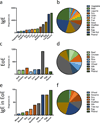The Prevalence of Eosinophilic Esophagitis in Pediatric Patients with IgE-Mediated Food Allergy
- PMID: 28042003
- PMCID: PMC5346349
- DOI: 10.1016/j.jaip.2016.11.020
The Prevalence of Eosinophilic Esophagitis in Pediatric Patients with IgE-Mediated Food Allergy
Abstract
Background: Eosinophilic esophagitis (EoE) is an allergic inflammatory disease that is triggered by food allergens and characterized by progressive esophageal dysfunction. Recently, EoE has been identified in patients who underwent oral immunotherapy (OIT) for IgE-mediated food allergy, suggesting an association.
Objective: We sought to ascertain whether significant associations exist between IgE-mediated food allergies and EoE.
Methods: Using the analysis of electronic medical record data and manual chart review, we examined our subspecialty care network of 35,528 children and adolescents to identify and characterize patients with IgE-mediated and EoE food allergy. The most common food allergens were defined, and the prevalence of EoE in patients with IgE-mediated food allergy was determined. Logistic regression was used to measure the extent to which IgE-mediated food allergy to specific foods is associated with EoE.
Results: The most common causes of EoE were milk, soy, egg, grains, and meats, an allergen pattern that is distinct from that of IgE-mediated food allergy. The prevalence of EoE in patients with IgE-mediated food allergy was higher than that reported in the general population (4.7% vs 0.04%). The distribution of IgE-mediated food allergens in patients with EoE was similar to that of the general population, and IgE-mediated allergy to egg (2.27; 1.91-2.64), milk (4.19; 3.52-4.97), or shellfish (1.55; 1.24-1.92) was significantly associated with an EoE diagnosis.
Conclusions: Our findings support a clinical association between these conditions that has implications for the management of children with food allergy, and particular relevance to patients undergoing OIT.
Keywords: Eosinophilic esophagitis; Food allergy; IgE; Oral immunotherapy; Prevalence.
Copyright © 2016 American Academy of Allergy, Asthma & Immunology. Published by Elsevier Inc. All rights reserved.
Figures


References
-
- Jackson KD, Howie LD, Akinbami LJ. Trends in allergic conditions among children: United states, 1997–2011. NCHS Data Brief. 2013 May;(121):1–8. 121. - PubMed
-
- Sicherer SH, Sampson HA. Food allergy: Epidemiology, pathogenesis, diagnosis, and treatment. J Allergy Clin Immunol. 2014 Feb;133(2):291,307. quiz 308. - PubMed
-
- Branum AM, Lukacs SL. Food allergy among children in the united states. Pediatrics. 2009 Dec;124(6):1549–1555. - PubMed
-
- Gupta RS, Springston EE, Warrier MR, Smith B, Kumar R, Pongracic J, et al. The prevalence, severity, and distribution of childhood food allergy in the united states. Pediatrics. 2011 Jul;128(1):e9–e17. - PubMed
MeSH terms
Substances
Grants and funding
LinkOut - more resources
Full Text Sources
Other Literature Sources
Medical

